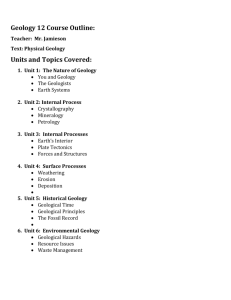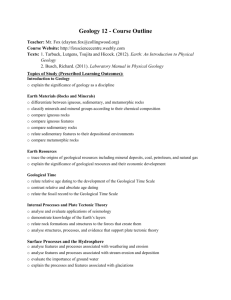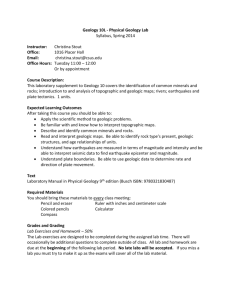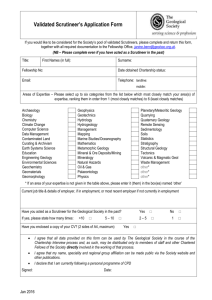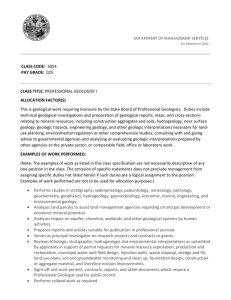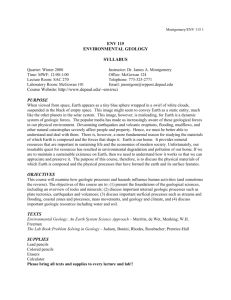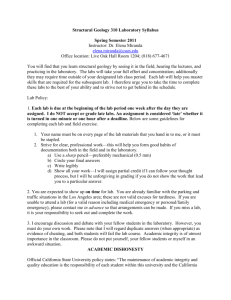GY 360 Structural Geology Laboratory Course Syllabus
advertisement
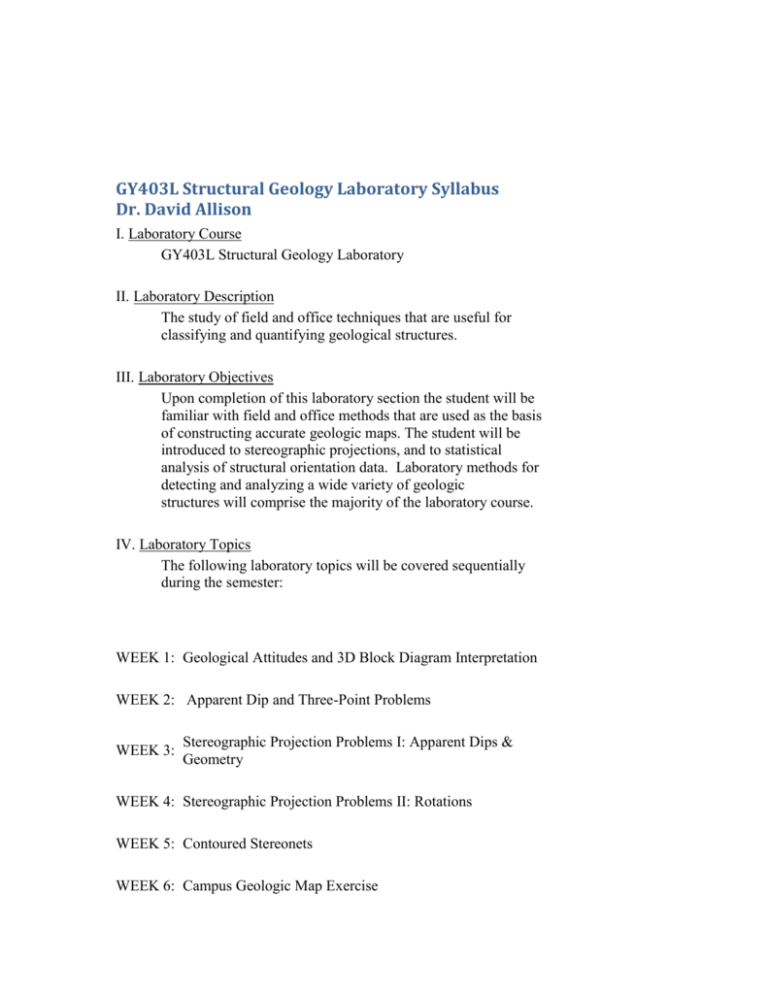
GY403L Structural Geology Laboratory Syllabus Dr. David Allison I. Laboratory Course GY403L Structural Geology Laboratory II. Laboratory Description The study of field and office techniques that are useful for classifying and quantifying geological structures. III. Laboratory Objectives Upon completion of this laboratory section the student will be familiar with field and office methods that are used as the basis of constructing accurate geologic maps. The student will be introduced to stereographic projections, and to statistical analysis of structural orientation data. Laboratory methods for detecting and analyzing a wide variety of geologic structures will comprise the majority of the laboratory course. IV. Laboratory Topics The following laboratory topics will be covered sequentially during the semester: WEEK 1: Geological Attitudes and 3D Block Diagram Interpretation WEEK 2: Apparent Dip and Three-Point Problems WEEK 3: Stereographic Projection Problems I: Apparent Dips & Geometry WEEK 4: Stereographic Projection Problems II: Rotations WEEK 5: Contoured Stereonets WEEK 6: Campus Geologic Map Exercise WEEK 7: Thickness and Depth Problems WEEK 8: Outcrop Prediction WEEK 9: Stress Analysis WEEK 10: Spring Break (March 14-18) WEEK 11: Strain Analysis WEEK 12: Fault Net Slip WEEK 13: Geological Cross-sections WEEK 14: Field Mapping Project (High Fall Branch April 16-17; Tent Camping) WEEK 15: Review for Final WEEK 16: Lab Final Practical (April 28, Th.2-5PM; open book) V. Text Structural Geology Laboratory Manual by David T. Allison, 4th Edition VI. Procedures for Assessing Student Performance You will be required to obtain certain materials to complete the laboratory assignments. A list of required lab tools and supplies follows: Required Tools & Supplies NOTE: the below links are suggestions- better deals may be found elsewhere! 1. Drawing pencils ( 0.5mm, HB and 2H lead). 2. Engineers Scale (Engineer's Scale: 10ths, 20ths, etc. inch). 3. Protractor (6 inch diameter, cut-out center). 4. Colored Pencil Set 5. 8.5" x 11" smooth, hard surface drawing paper, suitable for use with a pigment liner. Good quality inkjet paper should work. 6. 8.5 x 11 vellum (50 sheets). 7. Drafting tape or "Drafting Dots". 8. 2 inking triangles (30-60-90 ) 9. A compass for drawing circles 7 inches diameter. You do not have to get an expensive engineering compass- any type will do. 10. Pigment liner Drafting Pens (set of 5) 11. Plastic Eraser 12. Two Notebooks, 3-ring binder type for holding 8.5 x 11 inch paper. 13. Calculator with trig functions. 14. Field "Rite in Rain" notebook 15. Field "Rite in Rain" pen Optional Tools 1. Drafting Board - these can be very handy if you want to work on your labs at home. 2. Clipboard for field mapping exercise. 3. USB “Jump drive” for storing applications and data. 4. Field book cover. 5. Rock pick List of Vendors for Above Supplies (NOTE: no single vendor will supply all of the above equipment and supplies) 1. Forestry Suppliers (online) 2. USA Bookstore 3. Anders Bookstore 4. Mobile Instrument (Mobile AL) 5. Hobby Lobby (Mobile AL) 6. Alabama Art Supply (Mobile AL) 7. Office Depot 8. Amazon.com (online) Exam & Assignment Percentages The percentage weightings for exams and assignments are as follows: LABORATORY GRADE PERCENTAGES Average of lab assignments: 30% of Lab grade Lab Practical exam: 50% of Lab grade Lab Problem Review Participation: 20% of Lab Grade Lab Assignment Page Format Page size is letter (8.5" x 11"). Use this format for each problem unless otherwise instructed. In some cases a scale or north arrow may not be required. Exercise Number Problem Number Scale (is applicable) Numerical Answers: North Arrow (if applicable) Center problem on page Center problem on page Lower Right Corner: Name (printed) Date Due A 3-hole punch binder notebook will be required for the lab problems. Having your problem sets together in one place will aid you in this course and in the future. Notebooks will be kept according to the below guidelines. Failure to use guidelines will result in the deduction of points: 1. Exercise assignment sheet(s) for the week will precede all problems for that week. 2. Labs must be done on lineless paper and entered into the notebook (i.e. use a 3-hole punch). 3. Only one problem or portion of a problem per page. 4. Problems must be labeled on every page as shown below: 5. ASSIGNED SCALE MUST BE USED. Failure to comply will result in no credit for that problem. 6. All problems should be done in black ink with a rapidograph, unless otherwise instructed. 7. Neatness and accuracy go together. Accuracy required for full credit will be determined by problem difficulty and by scale. Neatness will account for 10% of each lab assignment. 8. Some problems will require a written portion outlining the procedures used to solve the problem. The written portion should be placed in the bottom third of the problem construction, or it should be entered beginning at the top of a separate sheet. Exercises assigned in lab will be due at the beginning of the next laboratory period unless otherwise announced. Since I always go over the answers to the previous assigned lab at the beginning of class, there is no possibility of turning in a "late" lab. The lab period will be devoted to a review of previous assignments and instruction on and demonstrations of new problem material. All assignments are to be done as independent work. I encourage you to discuss the principles involved with your classmates. However, if you depend on your fellow class members too heavily you will have great difficulty with the laboratory final examination. Because this examination composes a large proportion of your laboratory grade, it is unlikely that you can pass the laboratory if you rely heavily on your classmates, or old labs from former students, for answers to weekly assignments. It is very important that, if you are having problems, you should seek the instructor or laboratory assistant for assistance. Most principles involved with a given lab are built upon those learned in previous labs, so you cannot afford to fall behind in this class. Students should note that there is a required Sat.-Sun. field trip for the 7th laboratory (Tannehill State Park near Tuscaloosa AL) during the 7th week of class. This field exercise will be one of the few opportunities prior to a summer field course that you will have a firsthand opportunity to learn the techniques of geological field mapping. The University of South Alabama provides reasonable accommodations to qualified individuals with disabilities. Please see me if you have special needs. VII. Instructors for the Course Instructor: David Allison Office: Room 344 LSCB Office Hours: Will be posted on office door This course is usually provided a student assistant for the laboratory whose main function is to assist students completing the laboratory exercises, and to assist the instructor in grading. The student assistant, if available, will be announced during the first lab. It is recommended that students take advantage of the knowledge available from the laboratory teaching assistant. VIII. Bibliography Davis, George H., and Reynolds, Stephen J., 1996, Structural Geology of Rocks and Regions, 2nd ed. : John Wiley & Sons, Inc., New York, New York, 776p. NOTE TO GEOLOGY MAJORS: Every semester the Geology/Geography Department designates a specific week as advising week. This is the period designated for you and your advisor to meet and discuss your progress and future courses. Please take advantage of this designated time- your advisor may refuse to advise you at other times. Be aware that you should meet with your advisor every quarter so that the departmental secretary can mark you from the registration "hold" list. It is your responsibility to make an appointment with your advisor, and to make sure that he/she marks you off of the registration "hold" list after you have been advised. If you are on the hold list you will not be able to register with phone registration. You can check with the departmental secretary each semester to determine the dates of advising week. dallison@southalabama.edu David Allison Home Page USA Undergraduate Bulletin University of South Alabama

